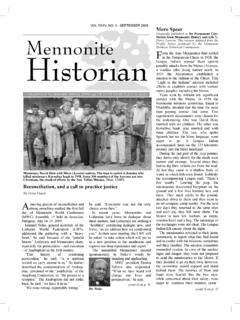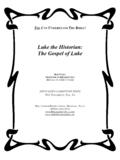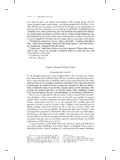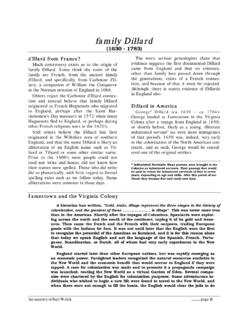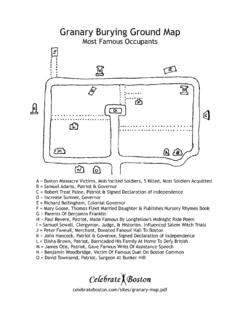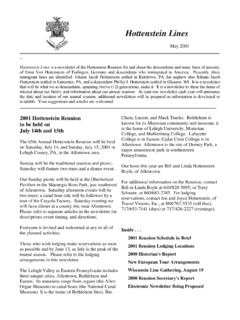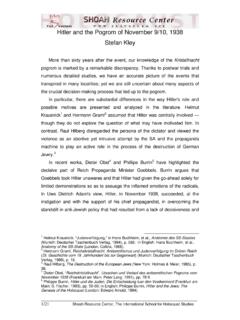Transcription of MENNONITE HISTORIAN
1 MENNONITE HISTORIAN Published by the MENNONITE Heritage Centre and the Centre for MB Studies in Canada The ordination and installation of Rev. Arnold Bachmann on October 2, 1932. Those seated in the front include the following (r-1): No. 5: Curator Jacob Rupp; No. 10, Rev. Arnold Bachmann; and No. 11: Rev. Heinrich Pauls; Photo: From Galiziens Mennoniten im Wandel der Zeiten, p. 630 (in the picture section). Mennonites from Galicia (Kieinpolen): Some Historical Notes by Glen Linscheid The historical accounts of cruel persecu-tions unto death suffered by the early Swiss Anabaptists have been well-documented. Seeking escape and refuge, many fled into the Rheinpfalz of the German Palatinate. One source puts it this way: "After the Thirty Years' War the Rheinpfalz was in a sorry state. Trees and brush covered much of the fields.
2 Of livestock there was practically none .. The Elector wanted his former peasant land, now reduced to rubble, to be populated again with strong workers."' Providential concessions and inducements caused their Rheinpfalz sojourn to prosper, despite some~njust restrictions, leading to an eventual over-abundance of settlers, usually with large families. We quote another histori-an as follows: "By today's standards the con-ditions under which the Anabaptists settled in Germany would seem somewhat discrimina-tory. They were allowed freedom of worship but forbidden to build their own churches, were not allowed to meet in groups larger than twenty members, and were prohibited from doing evangelistic work among their neigh-bours. Later they were denied the right to live in cities, and marriage required the consent of the government.
3 "' In I 772, upon the first partition of Poland, Galicia (Kleinpolen) became part of the Austrian Empire. Galicia was a predominate-ly agrarian society, undeveloped culturally, with a peasant population largely uneducated and poor. Large sections of the region were properties of the Church and the aristocracy. Monasteries also had large land holdings. The Polish nobility valued hunting and other entertainments above developing the land and its people. Galicia was wild and untamed. In I 780 the Austrian emperor, Franz Joseph II, extended an offer to German farm-ers to settle the land gained through this Polish partitioning. Thus in I 784 six MENNONITE families joined this eastward flood of human-Volume XX I , No. 3, September, I 995 ity out of Germany. The MENNONITE surnames included Bachmann, Ewy, Krehbiel, Mundelien and Schrag.
4 By 1786, twenty-one more families followed them. Their surnames included Bergthold, Brubacher, Huwen (Hubin), Klein, Kintzi, Linscheid, Merk, MAller (Miller), Rupp and Schmidt. The first settlement was named Falkenstein after their Rheinpfalz horne. Its location was about 40 kilometers southwest of Lemberg (L'vov, L'viv), their chief cultural, governmental and economic center. New settlements grew as the population increased. Einsiedel and Rosenberg spawned the daughter colonies of Neuhof, Kiernica, Wiszenka, Ehrenfeld, Troscianiec, Debrovalny, Lipowice and Podusilna. Following the lead of some 80 years earlier, in I 862, another smaller group from the Rheinpfalz settled in Galicia. Their surnames included Forrer, Jotter, Laise (Leisy) and Stauffer. The total MENNONITE population increased from 72 families in 1856 to 142 fam-ilies in 1880.
5 Up to this time, pastors were chosen from within the congregation. But with settlements being in such scattered locations, the lament of "we are sheep without a shepherd" was heard. A further quote has it thus: "The number of elders and preachers was not sufficient to meet the needs of the ever-spreading church. So in I 860 Johann Klein and Jakob Mueller were elected preachers .. Those at Kiernica formed their own congregation in fellowship with the large one at Einsiedel. They chose Johannes van der Srnissen as their elder .. But van der Smissen had hard going, inas-much as some members and preachers had freer thoughts about some points of doctrine. Even today (1934), some talk about the "reli-gious war of the Mennonites in 1865."3 Attempts at bringing in other preachers from outside the congregation during the years 1910-1929 proved less than favorable for var-ious reasons.
6 Heinrich Pauls, Leopold Gesell and Christian Guth pastored during those years. "As the congregation saw that preachers from another land could not adjust to, or fit into local conditions, and despite mutual efforts, preacher and congregation felt strange (cont'd on page 2) Page 2 Mennonites from Galicia (cant' d from page 1) to each other. They decided to send one from their midst to (obtain) theological education, furnishing the finances for it. They found such a one in Arnold Bachmann.'' "Four and one-half years the church was without a minister till Arnold Bachmann fin-ished his studies (at Tuebingen, Greifswald and Vienna) and returned."' Heinrich Pauls was recalled from Germany to ordain Arnold Bachmann on October 2, 1932. Of notable interest is the fact that Pauls was a leading light in the formation of the MENNONITE World Conference.
7 The devastating effects of two world wars took a tragic toll of Galician MENNONITE Jives and property. In effect, all these families were forced to flee their homeland, a fate endured by many caught in the web of warfare. Following World War II, resettlement efforts brought many of these refugees to the USA, to Canada, and to Uruguay. Many also resettled in what was then West Germany. It was in Hlchst am Odenwald that Arnold Bachmann came to reside with his family . "Now he (Arnold Bachmann) could put his plan into action to write a book about the Mennonites in Galizien as a continuation of Peter Bachmann' s book, Mennoniten In Kleinpolen .. In 1983 the job was done (gathering genealogical data by many volun-teers) and Paster Arnold Bachmann also fin-ished his book. A year later the book was pub-lished in 700 copies.
8 A work was created which describes the history of the Mennonites in Galicia from 1784 till the parish ceased to exist in 1939. So lives Arnold Bachmann in our memory not only as a dedicated pastor, but also as the author of the family history of the Galician Mennonites. His mortal remains were put to rest on 20 September 1990, in Heubach (Germany)."' Regarding traces of this heritage remaining to the present as evidentiary testimony to their historic plight, the following account is highly significant to those seriously studying this slice of our past: "As we return, Ganna, a friendly woman motions to us. We follow her down steep stone steps into the cellar of the vintage house. There a supporting beam reads, "Peter Linscheid, 1827." It is her way" of con-necting to my past. Hers is one of the few buildings (in Einsiedel) that survived the battle orance JaworJw Szkto 0 Q.
9 -Janow Rem~now Rogoino Mszana Skntt o . Lemberg Rusif6w 0 Laszki Grodek JZimnawoclaOIAJ rr\lf: 0 ~ 0 r/inniki 0 Barszczowi Wotostkow L2J . Kulparkow Jydiatycze 0 ., Kiernica Kurowi . - ,Neuhof Lubienw~odsadki 0 Wisz enka Rudki II Q . Mifoszowice Przemyslan) . Podhajcz~ o~tf0'0 ~-~~ .. Chr~s-~o 0 wen 1 c e e Fa 1 ken 5 tei_[lQ ~osenoDornfe I d Humtente c ,~Dero Q owice Q e Reichenbach tabokruki Horozanna w Strzel i ska. nowe ~ MENNONITE settlements around Lemberg (today L'vov in Ukraine). From a map drawn by Arnold Bachmann. This map is available in Galiziens Mennoniten im Wandel der Zeiten. zones of 166 years."' As for Galician MENNONITE descendants holding Canadian citizenship, their numbers can be traced mainly to post-WWII refugee status. Canada became their new home in the late 40s and early 50s.]
10 Addresses to which the author sends an armual newsletter (Along the Galician Grapevine) include Winnipeg, MB; St. Catherines and London, ON; as well as Lethridge, AB and Landis, SK! Endnotes I. Peter Bachmann. Mennoniten In Kleinpolen (1934), 91. Cf. also an unpub-lished summary translation by Albert F. Rupp, Los Angeles, CA, p. 11. 2. Lola (Regier) Friesen. Kintzi. The Story of Theodore and Wilhelmine (Linscheid) Kintzi and their Descendants (North Newton, KS, 1986), B-1. 3. MIK, 39; Rupp, 242. 4. MIK, 62; Rupp, 351. 5. MIK, 62; Rupp, 351. 6. Cf. Dyck, "History of the MENNONITE World Conference", MENNONITE World Handbook (Lombard, ILL: MWC, 1978), 1-9. 7. Romauld Mueller in a funeral oration given as a final tribute to Deacon Arnold Bachmann, the last pastor of the Lemberg-Kiernica (Galicia) MENNONITE parish, 20 September 1990, Heubach, Germany.

